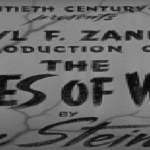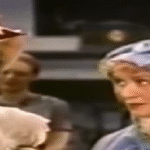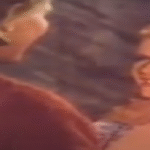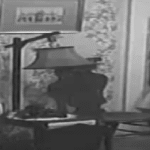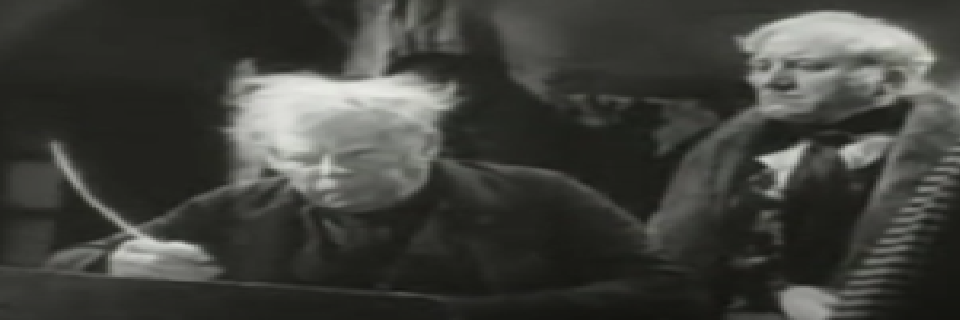The 1935 film Scrooge, directed by Henry Edwards and starring Seymour Hicks in the title role, is one of the earliest sound adaptations of Charles Dickens’ A Christmas Carol. It remains a significant portrayal, not only for its atmospheric use of early cinematic techniques but also for the gravitas brought by Hicks, who had long been associated with the character on stage. Though it runs for just over an hour, Scrooge offers a sombre, gothic interpretation of the classic redemption story, capturing both the bleakness and the hope of Dickens’ original work.
The film opens in a stark, shadowy London, a city cloaked in fog and bitterness on Christmas Eve. Ebenezer Scrooge, an ageing, tight-fisted moneylender, is introduced at work in his dismal counting-house. His disdain for Christmas is immediate and palpable; he snarls at his underpaid clerk, Bob Cratchit, for seeking time off and rudely rebuffs his cheerful nephew Fred, who has come to wish him a merry Christmas and invite him to dinner. The setting is grim and austere, reinforcing Scrooge’s inner coldness.
As evening falls, Scrooge trudges home alone to his cavernous and gloomy chambers. Here, the supernatural elements of the story begin to unfold. Scrooge is first disturbed by strange visions, the door knocker seems to transform into the face of his long dead partner, Jacob Marley. After settling uneasily into his quarters, Scrooge is confronted by Marley’s ghost in a chilling scene notable for its restraint; instead of grand special effects, the spirit’s presence is suggested through simple, eerie visual cues and a haunting voice.
Marley’s spectre, draped in chains forged from ledgers, cash boxes, and padlocks, warns Scrooge that he is headed for the same eternal torment unless he changes his miserly ways. Marley foretells that Scrooge will be visited by three spirits who will offer him a chance at redemption. The weight of this warning sets the tone for the strange night ahead.
The first spirit, the Ghost of Christmas Past, soon arrives. Unlike more elaborate later depictions, the ghost here is an indistinct figure, almost dreamlike. It takes Scrooge back to scenes from his own life, his lonely childhood at a boarding school, his early apprenticeship under the jovial Mr Fezziwig, and his lost romance with a sweet young woman named Belle, who leaves him after realising that he has come to love money more than her. These flashbacks are poignantly rendered, with soft lighting and muted tones that evoke the distance and sadness of memory.
The second spirit, the Ghost of Christmas Present, appears next, shown simply as a kindly figure clad in a traditional robe. This spirit reveals the lives of others celebrating Christmas despite hardship. Scrooge is shown the humble Cratchit household, where the family gathers around a small but lovingly prepared Christmas meal. Bob Cratchit’s youngest son, Tiny Tim, captures Scrooge’s attention, the boy’s frailty and cheerful spirit tug at something deep within the old miser. The Cratchits’ resilience and affection highlight the stark contrast to Scrooge’s own lonely existence.
The vision of Christmas Present also includes glimpses of others revelling in the season, gatherings of miners, sailors, and merrymakers across England, reinforcing the universality of Christmas cheer and human fellowship, from which Scrooge has long isolated himself.
The final and most frightening apparition, the Ghost of Christmas Yet to Come, is depicted as a silent, black-cloaked figure, the very embodiment of dread. Without a word, it guides Scrooge through scenes of an unfeeling future. He witnesses the death of Tiny Tim, the Cratchits mourning in quiet despair. He then sees a group of businessmen casually discussing the death of a despised figure, a man who, it becomes clear, is Scrooge himself. Eventually, he is led to a neglected grave bearing his name.
Terrified and desperate, Scrooge pleads for a chance to change his fate. He promises to honour Christmas in his heart and to live with compassion and generosity henceforth. With a jolt, he awakens in his own bed on Christmas morning.
Overwhelmed with relief and joy, Scrooge immediately sets about making amends. He sends a lavish turkey to the Cratchit household via a young errand boy, donates generously to the same charitable cause he had earlier dismissed, and later joins Fred’s Christmas celebrations, warmly embracing the family he had previously rejected.
The final scenes of the film depict a transformed Scrooge, now a benevolent figure who becomes a second father to Tiny Tim and a friend to all. His redemption is presented not with grand fanfare but with a sense of genuine, quietly profound change.
The 1935 Scrooge is notable for its atmospheric style. Owing in part to its limited budget, the film relies heavily on shadows, fog, and minimalist sets to convey mood. Rather than show the spirits in elaborate form, much of their presence is suggested through light, voiceovers, and clever editing. While some modern viewers might find these effects understated, they lend the film a haunting, dreamlike quality that suits the story’s themes of memory, fear, and hope.
Seymour Hicks’ portrayal of Scrooge is the beating heart of the film. His Scrooge is truly grim and forbidding at the outset, gaunt and almost spectral himself, making his transformation all the more powerful. Hicks, who had played Scrooge on stage for decades, brings a depth of understanding to the role that imbues the character with credibility and nuance.
In contrast to later adaptations that often soften the darker elements, the 1935 Scrooge leans into the horror and melancholy of Dickens’ tale. It does not shy away from depicting the misery and hardship faced by the poor, nor does it trivialise Scrooge’s initial cruelty. Yet, it remains a hopeful story, affirming the possibility of change even for the most hardened soul.
In sum, the 1935 Scrooge is a brooding, thoughtful adaptation of Dickens’ timeless tale. Its blend of stark realism and ghostly atmosphere, combined with a central performance of great intensity, ensures that it remains a compelling interpretation. Though less glossy than later versions, it captures the true spirit of A Christmas Carol: the enduring belief that redemption, charity, and kindness are within the reach of everyone, no matter how lost they may seem.

